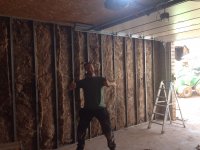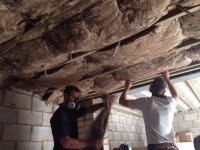I'm definitely not an expert in this field, but do have some experience with it, being in the audio/video field as well. Back in the day [bout a decade ago], we actually built the very first THX-certified residential screening room in the country. First resi theatre room with an official THX plague and certified by THX engineers. Worked on a slew of rooms requiring isolation. I've personally worked with and installed various materials choices out there: greenglue, quietrock, vinyl loaded barriers, staggered stud walls, isolation clips on resilient channeling, floating walls, complete rooms within a room, etc. The one common denominator: isolation done well is not cheap, and your investment can be easily screwed up by improper install of an otherwise good solution/product.
Like others have mentioned, first determine what level of noise you'd like to eliminate. And also try to think of a budget you'd like to set up for this [trust me, it can get expensive quick]. There are vendors and consultants out there ,as well, who could help, too. Unless you're independently wealthy, most people do as much isolation as they can within their budget. Quietrock is expensive and not the easiest to work with. Used it in the past on a few projects, but accomplished the same or better with some of the easier options out there as well. I wouldn't choose to use it again. Room within a room or staggered stud buildouts tend to be more straightforward and cost-effective builds. As for the amount of gap between the walls, my experience has been that you don't need much to be quite effective--just a few inches. But you do need some. Another option [either with or without the room within a room]: using isolation clips and resilient channeling to eliminate noise transfer. While not rocket-science, that option needs to be implemented correctly by all affected trades [whomever installs the clips & channeling; sheetrockers; etc.], otherwise the benefit can be lost/compromised. This is one of the reasons why calling for two layers of rock instead of floating the walls on channeling is so popular--it's difficult for all involved trades to screw that up.
Another area where people screw up with isolation is improper treatment for all the penetrations into the room [electrical boxes; pipes; HVAC; etc.] You wouldn't wont to drop $ on a room-within-a-room build, only to compromise its performance by not addressing the penetrations needed into the space.
Kinetics Noise Control is a good source for isolation help. They're a manufacturer, but also very helpful in giving consult. Let them know what you're planning to do and they can offer some suggestions. Kinetics sources IsoMax clips as well [we've used RSIC-1 clips from PAC Intl, too]. Roxul is great for sound proofing and insulation use.
Isolation isn't cheap, but it doesn't need to be "exotic extravagant either. Yes, you may get better isolation from a wider gap between the walls or the use of a special compound or glue. But remember you should be striving for a cumulative effect of multiple isolation solutions that wont break your budget. I wouldn't blow the budget on one exotic soln. But address the isolation in as many areas as feasibly possible, preferably in the areas that will yield the greatest results. After talking with Kinetics and others, you may find that there could be a cost-effective way of isolating the primary noise generators [compressors, etc.] themselves. That would benefit not only your neighbor, but you as well.


